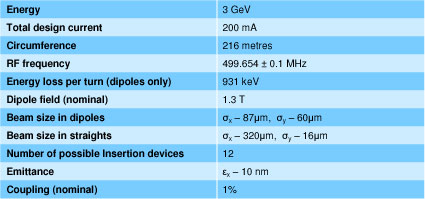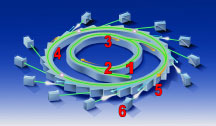The information in this section is intended for people who already have some knowledge of physics. Less-technical information about how synchrotrons work and what they do is available in the 'ABOUT SYNCHROTRONS' section.

Inside the Australian Synchrotron storage ring, where bunches of electrons travel at close to the speed of light
1. Electrons are produced at the electron gun by thermionic emission from a heated tungsten matrix cathode.
Applying a 500 MHz voltage signal to the gun as it fires means the electrons are generated in bunches two nanoseconds apart. The emitted electrons are then accelerated to an energy of 90 keV (kilo electron volts) by a 90 kilovolt potential difference applied across the gun, and move into the linear accelerator.
2. The linear accelerator (or linac) accelerates the electron beam to an energy of 100 MeV (mega electron volts) over a distance of about 10 metres. This involves a series of RF (radiofrequency) cavities operating at a frequency of 3 GHz. Due to the nature of the acceleration, the beam must be separated into discrete packets, or ‘bunches’, with a spacing consistent with the 3GHz acceleration frequency of the linac. This is done at the start of the linac, using several ‘bunching’ cavities. The linac can accelerate a beam once every second. After the first metre of acceleration in the linac, the electrons are already travelling at more than 99.99% of the speed of light.
3. The booster is an electron synchrotron 130 metres in circumference that takes the 100 MeV beam from the linac and increases its energy to 3 GeV (giga electron volts). The booster ring contains 60 combined function (steering and focussing) electromagnets to keep the electrons inside the stainless steel vacuum chamber and a single 5-cell RF cavity (operating at 500 MHz) to supply energy for acceleration. The beam is accelerated by a simultaneous ramping of magnet strength and cavity fields. Each ramping cycle takes approximately one second for a complete ramp up and down. An electron spends about half a second in the booster ring and completes over one million laps.
4. The storage ring is the final destination for the accelerated electrons. It can hold 200 mA of stored current with a beam lifetime of over 20 hours. The storage ring is 216 metres in circumference and consists of 14 nearly identical sectors. Each sector consists of a 4.4 metre straight section and an 11 metre arc. Every arc contains two dipole ‘bending’ magnets where synchrotron light will be produced. Most of the straight sections have room for an ‘insertion device’. The storage ring also contains a large number of quadrupole and sextupole magnets used for beam focusing, chromaticity corrections and orbit corrections.
5. Individual beamlines are positioned to capture the synchrotron light given off by the storage ring.
The first section of every beamline is the photon delivery system (also called the ‘beamline optics’). It incorporates filters, monochromators, mirrors, attenuators and other devices to focus and select appropriate wavelengths for particular research techniques.
6. Experiments employing synchrotron light are conducted in customised facilities called end-stations. Most of the end-stations are housed inside radiation shielding enclosures called ‘hutches’ to protect staff and visitors from potentially harmful x-rays. Each beamline utilises the synchrotron light to gather data in the form of images, chemical spectra, and/or scattered light. Because research scientists cannot enter the hutches during data collection, much of the equipment is controlled remotely via motors and robotic devices.
Features
 The Australian Synchrotron is an advanced third-generation design. The magnet arrangement in the storage ring has been carefully designed to produce a high quality, low emittance, stable electron beam – and generate synchrotron light of high brilliance.
The Australian Synchrotron is an advanced third-generation design. The magnet arrangement in the storage ring has been carefully designed to produce a high quality, low emittance, stable electron beam – and generate synchrotron light of high brilliance.
Light from bending magnets, multipole wigglers and undulators enables a wide range of advanced experiments or measurements to be carried out. Each of the 28 dipole magnets is a source of synchrotron light and most straight sections can host an insertion device – giving the possibility of 30-plus beamlines at the Australian Synchrotron.
Two of the straight sections in the storage ring are used to host four 500 MHz RF cavities, which are essential for replacing the energy that the beam loses through synchrotron radiation. Because the cavities can only accelerate the electrons during half of their oscillation period, the electrons in the storage ring circulate in bunches separated by the wavelength of the cavities – 60 cm. These bunches, around seven cm long, mean that the synchrotron radiation is generated in a pulsed pattern. This property can be useful for time- resolved measurements.
In addition to the two dipole bending magnets in each sector, there are six quadrupole and seven sextupole magnets, giving a total of 84 quadrupole and 98 sextupole magnets in the storage ring. As well as keeping the electron beam focused, the magnets correct for chromatic aberrations caused by the energy spread of the beam. The sextupole magnets have additional coil windings, enabling them to act as corrector magnets (either vertical or horizontal) to help maintain a precise beam orbit. An array of 98 beam monitors around the ring allows for extremely accurate measurements of the beam position. The electron beam is focussed, on average, to a path 60 micrometres wide, with an orbit deviation of less than five micrometres. In comparison, a human hair is typically around 80 micrometres wide.
An electron energy of 3 GeV was chosen for the Australian Synchrotron storage ring to allow for the production of light at frequencies that encompass a wide range of the electromagnetic spectrum, from far infra-red to hard x-rays.
During its time in the storage ring, the electron beam will gradually decay away as individual electrons scatter off residual gas molecules and each other. To minimise these losses, the beam circulates inside a stainless steel, ultra-high vacuum chamber, at around 10-10 <-10 is superscript> millibars pressure (roughly equivalent to the moon’s atmosphere). However, there are still losses and the beam needs to be topped-up once or twice a day. Because beam losses cause the machine to emit radiation (high energy electrons colliding with matter create showers of radiation called bremsstrahlung), the machine is enclosed in radiation shielding walls consisting of concrete and lead to protect staff and users.
Low-conductivity water (similar to deionised water) cools the magnet coils without causing an electrical short circuit. To reduce the effects of thermal drift, the entire building and tunnel temperature are regulated to within 1 and 0.5 degrees Celsius respectively.
Applications
The accelerator physics group at the Australian Synchrotron is actively involved in several areas of accelerator research. Their aim is to improve the performance of the Australian Synchrotron and contribute to the development of the next generation of accelerators. Their research fields include reducing the electron bunch length through ‘low-alpha’ lattice tuning, non-linear dynamics studies and low emittance tuning through transverse coupling control. Direct benefits of this research will include improved beam stability and performance of beamlines.
To synchrotron users, the Australian Synchrotron is simply a highly intense source of light ranging from infrared to hard x-rays supplied at the end-stations of beamlines. The unique properties of synchrotron light mean that experimental results are far superior in accuracy, clarity, specificity and timeliness to those obtained using conventional laboratory equipment. Synchrotron techniques can generate images plus elemental, structural and chemical information from diverse sample types ranging from biological to industrial materials. The broad range of available wavelengths allow scientists to look at the size and shape of macromolecules and voids in bulk materials, peer into the biochemistry of single cells and delve all the way down to the bonds between atoms.

Further reading
Information about light sources around the world: www.lightsources.org
Evolution of synchrotrons: http://xdb.lbl.gov/Section2/Sec_2-2.html
Electron gun and linac details – http://ados.web.psi.ch/slsdesc/linac/
Click here for a pdf about the Australian Synchrotron light source.

